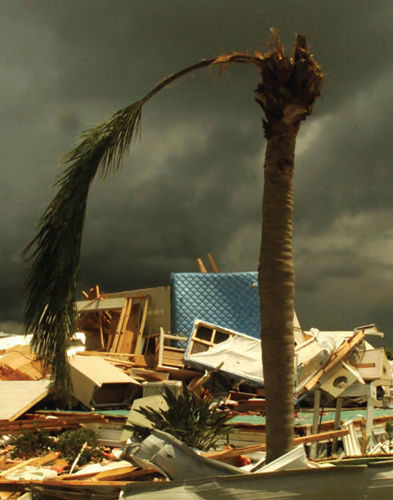The devastating effects of Superstorm Sandy’s storm surge may be the cause of profound underwriting changes in the property market

Superstorm Sandy may ultimately prove to be a monumental event for the insurance industry. Superstorm Sandy will likely be remembered as the second largest natural catastrophe in US history from an insured standpoint, following only 2005’s Hurricane Katrina.
A loss of this magnitude, close to a $25 Billion insured event, will change how some insurers view catastrophic property risk from both a frequency and severity standpoint. In her wake, the devastating effects of Superstorm Sandy’s storm surge may be the cause of profound underwriting changes in the property market. The surge caused not only widespread destruction of property, but power outages, damage to mass transit and extended recovery periods. The sea water damage was unprecedented.
The economic losses were significant. Industries spanning Transportation (Rail), Municipalities, Real Estate and Energy, among others were affected. Experiences from Superstorm Sandy, particularly her path and level of impact, have led to a new reality for property insurers. Given the large concentration of losses, insurers and reinsurers alike have begun to view property exposures in the Northeast through a new lens.
A loss of this magnitude, close to a $25 Billion insured event, will change how some insurers view catastrophic property risk from both a frequency and severity standpoint. In her wake, the devastating effects of Superstorm Sandy’s storm surge may be the cause of profound underwriting changes in the property market. The surge caused not only widespread destruction of property, but power outages, damage to mass transit and extended recovery periods. The sea water damage was unprecedented.
The economic losses were significant. Industries spanning Transportation (Rail), Municipalities, Real Estate and Energy, among others were affected. Experiences from Superstorm Sandy, particularly her path and level of impact, have led to a new reality for property insurers. Given the large concentration of losses, insurers and reinsurers alike have begun to view property exposures in the Northeast through a new lens.
While it is too soon to tell how price and capacity will ultimately be impacted, we do know that coverage terms and conditions for Northeast wind storms and storm surge perils will likely be re-defined:
● Given the perceived low degree of insured retention for this event, there may be new dialogue around the appropriate level of deductible for various natural catastrophe perils;
● Deductibles and pricing for named storms and floods in the Northeast may harden;
● There may be more demand for flood limits in exposed and adjacent Northeast locations;
● Some insurers may constrict capacity for wind and flood coverage in the Northeast;
● The industry may begin to apply aggregation management principles more similar to those that are used in the Southeast and Gulf regions of the United States;
● Industry models may be closely scrutinized and catastrophe exposures in the Mid Atlantic and Northeast US may be re-evaluated;
● There will be an increased reliance on engineering and an aggressive move to build models to better evaluate flood risk.
● Given the perceived low degree of insured retention for this event, there may be new dialogue around the appropriate level of deductible for various natural catastrophe perils;
● Deductibles and pricing for named storms and floods in the Northeast may harden;
● There may be more demand for flood limits in exposed and adjacent Northeast locations;
● Some insurers may constrict capacity for wind and flood coverage in the Northeast;
● The industry may begin to apply aggregation management principles more similar to those that are used in the Southeast and Gulf regions of the United States;
● Industry models may be closely scrutinized and catastrophe exposures in the Mid Atlantic and Northeast US may be re-evaluated;
● There will be an increased reliance on engineering and an aggressive move to build models to better evaluate flood risk.
Preparedness is the best response. We advise our Northeast broking partners and clients to review and clarify their policy wording, terms and conditions to ensure they are well prepared for any future events:
● Define ‘named’ storms in your policy and ensure that all insurance carriers on your policy are aligned to that definition;
● Ensure ‘wind mileage’ and deductibles/triggers are clearly defined;
● Understand and protect your coverage gaps;
● Understand the frequency of Northeast wind/flood/ storms beyond what the industry models portray – educate yourselves by reviewing the history with your carriers. The full impact of Superstorm Sandy will take some time to be realized by the property insurance market. Price will always be a factor in an underwriter’s decision to offer capacity for flood, earthquake and wind. However, it will be the clarity of terms and conditions around coverage for these perils, individual risk characteristics, and more importantly, deductible adequacy against potential for catastrophic loss, that will ultimately drive an underwriter’s decision making.
By Mike Nardiello, AIG
● Define ‘named’ storms in your policy and ensure that all insurance carriers on your policy are aligned to that definition;
● Ensure ‘wind mileage’ and deductibles/triggers are clearly defined;
● Understand and protect your coverage gaps;
● Understand the frequency of Northeast wind/flood/ storms beyond what the industry models portray – educate yourselves by reviewing the history with your carriers. The full impact of Superstorm Sandy will take some time to be realized by the property insurance market. Price will always be a factor in an underwriter’s decision to offer capacity for flood, earthquake and wind. However, it will be the clarity of terms and conditions around coverage for these perils, individual risk characteristics, and more importantly, deductible adequacy against potential for catastrophic loss, that will ultimately drive an underwriter’s decision making.
By Mike Nardiello, AIG



